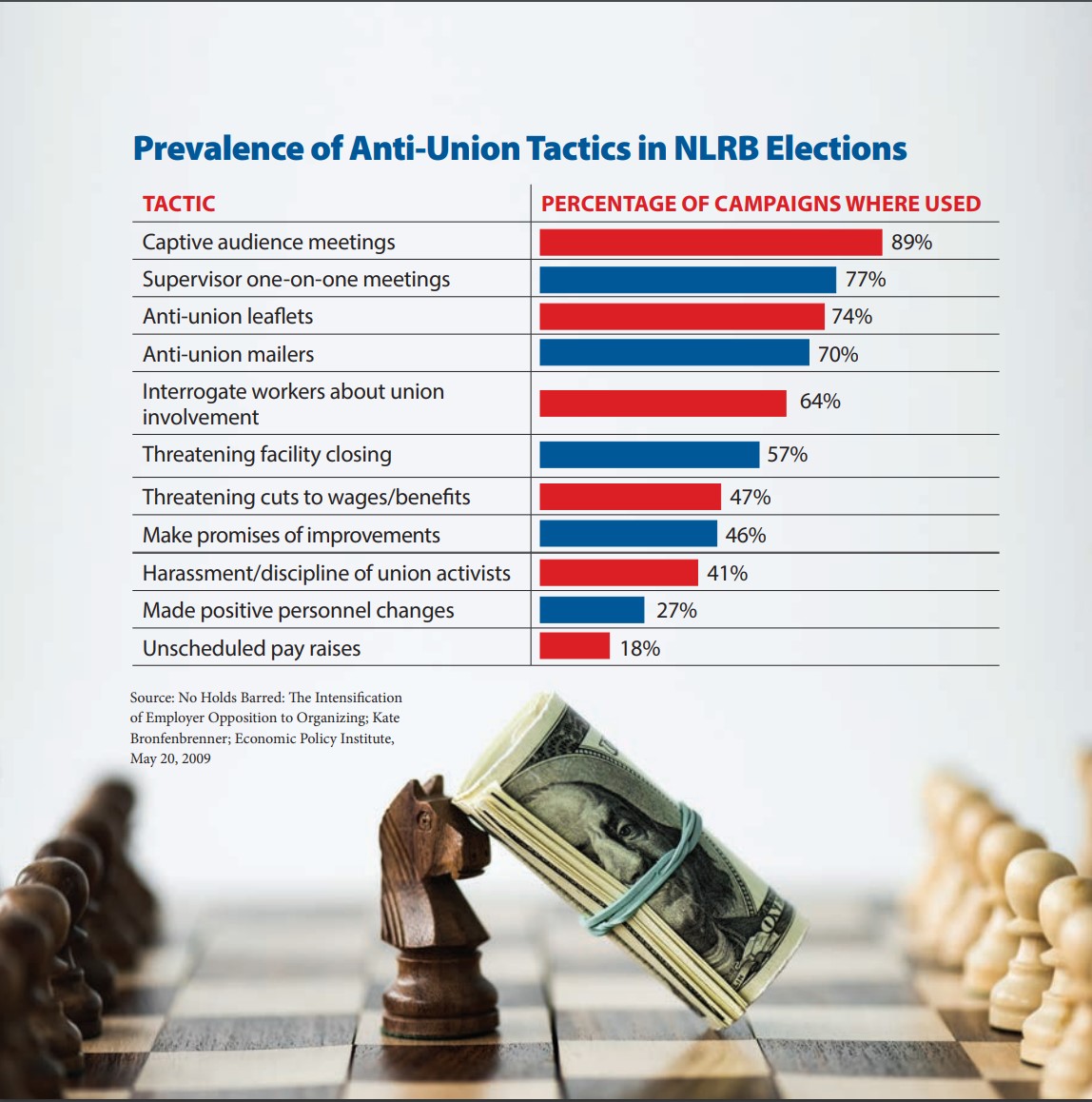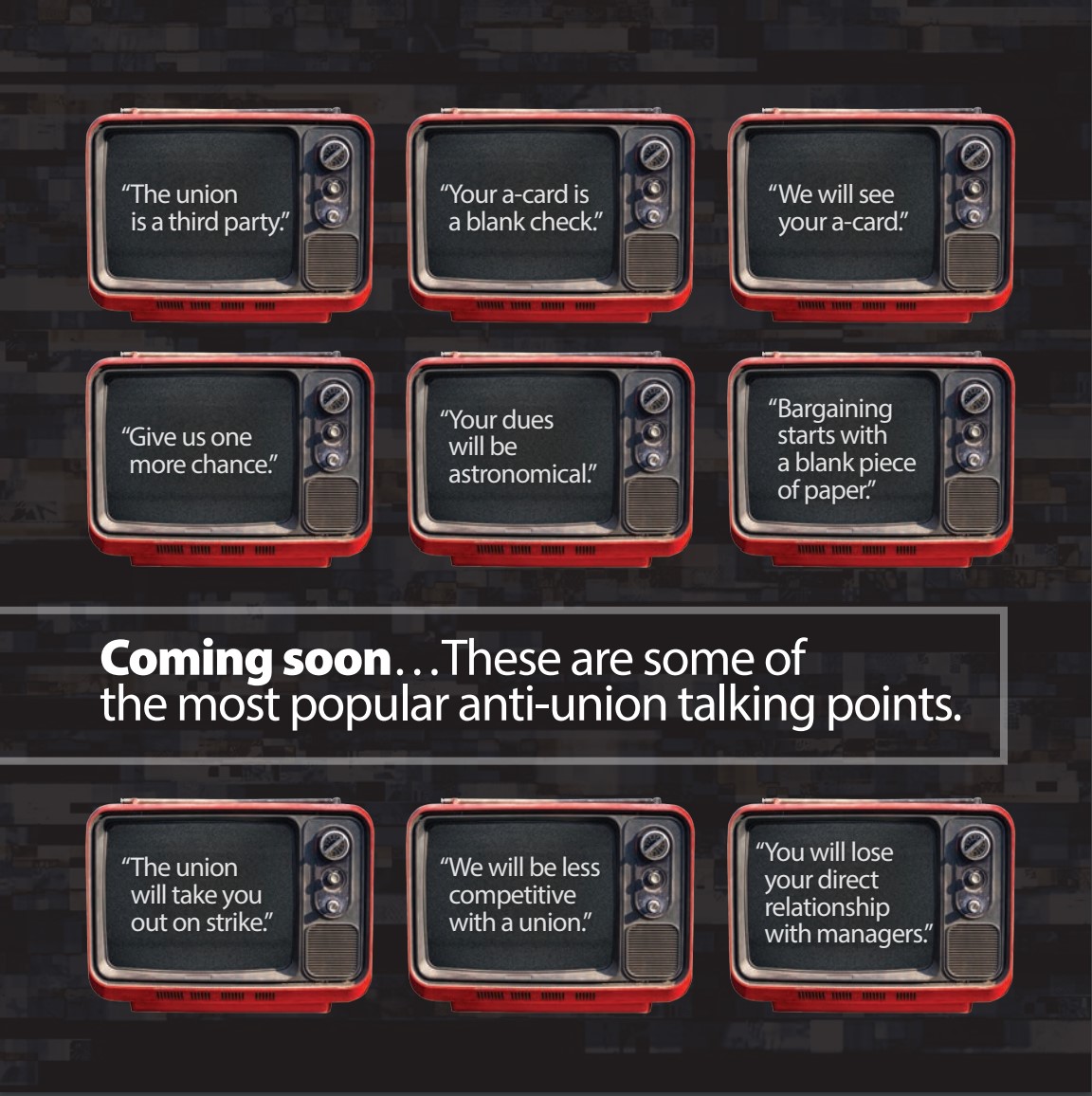The Anti-Union Campaign
Now that you and your co-workers have expressed interest in forming a union, it’s a pretty safe bet your employer is going to start spending crazy amounts of money on an anti-union campaign. Management’s anti-union campaign is meant to create a lot of noise and distract you from the real reason you are joining together in a union—there are problems at your worksite that only a union negotiated contract can fix.
The Lies
LIE: The Union is an Outsider. The union buster’s primary
objective is to paint the union as a third party. They will
undoubtedly go out of their way to portray the IAM as a big
business with fat cat executives. They will probably show graphs
about the loss in union membership that only tell half the story.
Then they’ll start in on dues, which they will harp on for the entirety
of your campaign.
TRUTH: YOU are the union. YOU decide what issues you want to negotiate with your employer. YOU form your negotiating
committee. YOU elect your local lodge, district lodge and
International leadership. YOU vote on whether to accept or reject
your negotiated collective bargaining agreement. The IAM will
provide bargaining assistance and a host of other services, but
ultimately your union will be as strong as you make it. Oh yeah, we
are a 501(c) non-profit organization. Not a for-profit corporation.
LIE: The IAM will spend all your money on politicians.
TRUTH: Dues money is not given to political candidates. Any
money for political candidates has to come from voluntary member
donations to the Machinists Non-Partisan Political League.
LIE: Collective Bargaining is a gamble. This is presented as
bargaining from zero. Union busters will claim that nothing is
guaranteed if you form a union, that your wages, benefits and more
could improve, stay the same or get worse. They will most likely
instruct you to ask union organizers to make unrealistic promises.
They are aiming to create doubt.
TRUTH: Your employer is required by law to bargain in good
faith. That means demonstrating a sincere effort to compromise
on proposals put forth by you and your negotiating committee.
It would be illegal for them to cut your wages or benefits in
retaliation for voting for the union. Therefore, everything stays the
same until you vote to approve a contract. And keep in mind—YOU
vote on that contract. So, you don’t have to vote for anything you
don’t want. If they really thought you would bargain down your
wages and benefits, why would they go to such extreme lengths to
oppose the union?
LIE: You’re going to lose your job. This will most likely be
presented as “we can’t afford the union” or “restrictive work rules”
won’t allow us to compete. Again, by making job security and issue
they are trying to create fear.
TRUTH: Your employer can choose to close your facility regardless
of whether a union is present. The reality is union members are
more satisfied and hence more productive at work. This reduces
costly turnover and makes worksites safer. Not to mention—a
union contract has mechanisms in place that can improve your job
security. These may include provisions that limit the employer’s
right to subcontract or outsource work. Most importantly, if you
fall under a union contract you are no longer an “at-will” employee.
As it stands, your employer can fire you, discipline you or change
your terms of employment without any justification. With a union
contract, you’ll have a form of due process the company must follow
in order to fire or discipline you. Union representatives will be there
to assist you during this process.
LIE: Your dues are going to be astronomical. They’ll claim your
monthly dues will be so extreme that you won’t be able to pay for
basic necessities. They may even make believe they know what
your “interests” are and claim you will be sacrificing those to pay
union dues.
TRUTH: Your dues will be roughly 2x your hourly rate per month.
That amount may change slightly when you, as union members,
propose and approve your local lodge bylaws. Per the IAM
constitution, no dues will be paid until a contract is ratified by the
membership. Dues get used for many important things such as
bargaining support, education, donations to community causes,
arbitration and legal services. You can’t put a price tag on the peace
of mind that comes with raises you can rely on.
LIE: The IAM will take you out on strike. This is one of the union
buster’s favorites. Like most of the anti-union campaign, they are
using fear as a means to evoke an emotional response from you.
They’re hope is fear will outweigh basic logic.
TRUTH: Strikes get a lot of publicity, but the odds you will ever go
on strike are slim. Every year, ninety-eight (98) percent of all IAM
contracts are negotiated without a strike, through businesslike,
professional negotiations with the employer. The IAM Constitution
ensures no one in the IAM can order or force a majority of members
to strike against their will. Members covered by the contract are
notified and given the chance to vote on the proposed agreement
and on whether to strike. It takes a simple majority (50%+ 1) of
those voting to accept a contract, BUT it takes a two-thirds (66.66)
majority to strike. With that said, sometimes union members do
vote to strike. It’s a source of power and often times it’s the best
way to protect ourselves against corporate greed. Strikes are
not taken lightly, however. That’s why it takes two-thirds of the
membership at your worksite to vote to authorize a strike.
LIE: You will no longer have a direct relationship with
management.
TRUTH: Did you ever really,
anyway? The reality is being able to sit down and negotiate with
your employer will finally start to balance the scales of power in your
worksite. That creates a MORE direct relationship with management
The Professional Persuader
Union-avoidance is a multi-billion-dollar industry. Professional “persuaders” are paid up to $400 an hour to spread lies and misinformation about unions. Despite drawing from the same, tired playbook campaign after campaign, anti-union consultants are regularly successful in dissuading workers from forming a Union. These individuals have no moral compass, relying on misinformation, intimidation and flat-out lies to emotionally beat down workers who want nothing more than to make positive change in their workplace.
“The key to my so-called union-prevention campaigns had always been to paint the labor organization as a greedy outsider and to convince supervisors and foremen that their job depended on its destruction. Meanwhile, I worked to recast upper management with a human face…. so workers would come to believe there was no need for a union.”
—Marty Jay Levitt, Confessions of a Union Buster
The Tactics
Hire a Union Buster and Train Supervisors: Roughly 75% of companies whose workers look to form a union hire an antiunion consultant or lawyer. These individuals like to work in the shadows. Therefore, one of the first things they do is train supervisors and middle management to be the front-line soldiers in the anti-union campaign. Since they have closer relationships with the workers, they are often seen as more effective messengers of the anti-union propaganda.
Attempt to Cause Confusion Surrounding Authorization Cards: One of the first things you can expect in an anti-union campaign is for management to try and misrepresent the true nature and purpose of the authorization card (a-card). They will probably refer to the a-card as a “blank check” and liken one to giving away your social security number. These methods are all about creating an atmosphere of fear and paranoia. The a-card’s sole purpose is to show the National Labor Relations Board (NLRB) there is sufficient interest in a union to hold a secret-ballot election. They are NOT membership applications and they are NOT shown to the company. You are NOT joining the union by signing a card. The only ones that see the a-cards are the union and the NLRB. In fact, it is illegal for the company to ask to see them.
Captive Audience Meetings: These are mandatory on-the-clock meetings between managers and workers. Their primary purpose is for the company and their hired professional persuaders to disseminate false or misleading information meant to discredit the union. Often, anti-union workers are planted and encouraged to
ask leading questions and sow seeds of doubt.
One-On-One Meetings: During many organizing drives, workers are required to attend isolated or even closed-door meetings with supervisors. This is the union buster’s primary method of assessing support for the union. It is also another opportunity to pressure or intimidate union supporters.
Promised or Token Improvements: Your company will likely try and rebuild trust by promising change is coming. They may install suggestion boxes or even remove some of the most notorious supervisors to demonstrate they are serious. They may even make unexpected improvements to your wages or benefits. The problem
is without a legally binding union contract, these improvements that are made can be taken back anytime and anywhere. Then it is back to business as usual.
Employee Testimonials & Vote No Committees: Management will pick favorites and make promises in order to secure vocal opposition to a union. They often recruit workers to form a “vote no” committee. That way they can circulate information that
appears to be from the workers’ point of view. Just remember—it is the union buster and management who are behind these efforts.
Whisper Campaigns: These are concerted efforts by anti-union managers and workers to spread rumors on the shop floor. Often no one knows where the information comes from … but it spreads quickly. Their aim is simple—plant seeds of fear among their co-workers.
Information Overload: Expect a barrage of emails, social media posts, letters to the home, leaflets and more. Not only is union buster trying to spread lies and false rumors, they are trying to overwhelm you with so much information that you become tired of hearing from both sides. That’s because human nature is to resort to the status quo when you’ve become worn down.



